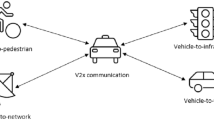Abstract
Vehicular ad hoc network(VANET) is the application of mobile ad hoc networks (MANETs) on the road of traffic. It is an important issue to achieve secure sharing of information among vehicles. Authenticated key agreement (AKA) is a good option to solve the problem. The security proofs of all known identity based two-party authenticated key agreement (IB2PAKA) schemes are given in the random oracle model(ROM). A cryptographic scheme, that is proven to be secure in ROM, is not necessarily safe in real life. Recently, Dang et al. presented an IB2PAKA scheme for VANET and claimed that it is provably secure in the extended Canetti-Krawczyk (eCK) model and ROM. In this paper, we indicate that Dang et al.’s scheme is not secure by showing two concrete attacks, then put forward a new IB2PAKA scheme and provide the security proofs in eCK model and the standard model (SM). Our scheme is suitable for VANET due to it does not require pairing operations and requires only four scale multiplication operations.




Similar content being viewed by others
References
Al-Riyami S, Paterson K (2003) Certificateless public . Advances in Cryptology-Asiacrypt 2003, LNCS 2894:452–473
Bellare M, Rogaway P (1993) Entity authentication and key distribution. Advances in Cryptology-CRYPTO’93 LNCS 773:232–249
Blake-Wilson S, Johnson D, Menezes A (1997) Key agreement protocols and their security analysis. 6th IMA International Conference on Cryptography and Coding, LNCS 1355:30–45
Bala S, Sharma G, Verma A (2016) PF-ID-2PAKA: pairing free identity-based two-party authenticated key agreement protocol for wireless sensor networks. Wireless Pers Commun 87(3):995–1012
Bala S, Sharma G, Verma A (2016) A non-interactive certificateless two-party authenticated key agreement protocol for wireless sensor networks. Int J Ad Hoc Ubiq Co 21(2):140–155
Bala S, Sharma G, Verma A (2018) Impersonation attack on Certificateless key agreement protocol. Int J Ad Hoc Ubiq Co 27(2):108–120
Canetti R, Krawczyk H (2001) Analysis of key-exchange protocols and their use for building secure channels. Advances in Cryptology-EUROCRYPT 2001, LNCS 2045:453–474
Cao X, Kou W, Yu Y, Sun R (2008) Identity-based authenticated key agreement protocols without bilinear pairings. IEICE T Fund Electr 91(12):3833–3836
Cao X, Kou W, Du X (2010) A pairing-free identity-based authenticated key agreement protocol with minimal message exchanges. Inform Sciences 180:2895–2903
Chen C, Hsu T, Wu H, Chiang J, Hsieh W (2014) Anonymous authentication and key-agreement schemes in vehicular ad-hoc networks. J Internet Technol 15(6):893–902
Dang L, Xu J, Cao X, Li H, Chen J, Zhang Y, Fu X (2018) Efficient identity-based authenticated key agreement protocol with provable security for vehicular ad hoc networks. Int J Distrib Sens N 14 (4):1–16
Dutta R, Dowling T (2011) Provably secure hybrid key agreement protocols in cluster-based wireless ad hoc networks. Ad Hoc Netw 9:767–787
Daniel R, Rajsingh E, adversaries Silas S. (2020) An efficient eCK secure identity based two party authenticated key agreement scheme with security against active. Inform Comput, vol.275 article id.1046309
Goya D, Nakamura D, Terada R (2016) Certificateless key agreement protocols under strong models. IEICE T Fund Electr, vol.E99A 10:1822–1832
Hao Z, Zhong S, Yu N (2013) A multihop key agreement scheme for wireless ad hoc networks based on channel characteristics. Sci World J 2013:13. Article ID 935604
Holbl M, Welzer T (2009) Two improved two-party identity-based authenticated key agreement protocols. Comput Stand Inter 31:1056–1060
Holbl M, Welzer T, Brumen B (2012) An improved two party identity-based authenticated key agreement protocol using pairings. J Comput Syst Sci 78(1):142–150
He D, Zeadally S, Xu B, Huang X (2015) An efficient identity-based conditional privacy-preserving authentication scheme for vehicular ad hoc networks. IEEE T Inf Foren Sec 10(11):2681–2691
Huang J, Yeh L, Chien H (2011) ABAKA: an anonymous batch authenticated and key agreement scheme for value-added services in vehicular ad hoc networks. IEEE T Veh Technol 60()
Huang B, Tu H (2015) Strongly secure certificateless one-pass authenticated key agreement scheme. Kuwait J Sci 42(1):91–108
Islam S, Biswas G (2012) An improved pairing-free identity-based authenticated key agreement protocol based on ECC. Procedia Engineer 30:499–507
Luo M, Zhao H (2015) An authentication and key agreement mechanism for multi-domain wireless networks using certificateless public-key cryptography. Wireless Pers Commun 81:779–798
Li Y, Zhu J, Zhang N, Wang X, Zhang Y (2015) RYY++: a novel povably secure identity-based authenticated key agreement protocol. Chinese J Electron 24(2):332–337
Lin H (2016) Secure certificateless two-party key agreement with short message. Inf Technol Control 45:71–76
LaMacchia B, Lauter K, Mityagin A (2007) Stronger security of authenticated key exchange. 1st International Conference on Provable Security, LNCS 4784:1–16
Ni L, Chen G, Li J (2013) Escrowable identity-based authenticated key agreement protocol with strong security. Comput Math Appl 65(9):1339–1349
Ni L, Chen G, Li J, Hao Y (2013) Strongly secure identity-based authenticated key agreement protocols in the escrow mode. Sci China Inform Sci 56(8):1–14
Ni L, Chen G, Li J, Hao Y (2016) Strongly secure identity-based authenticated key agreement protocols without bilinear pairings. Inform Sciences 367:176–193
Shamir A (1984) Identity-based cryptosystem and signature scheme. Adv Cryptology-Crypto 1984, LNCS 196:47–53
Shim K (2012) Cryptanalysis of two identity-based authenticated key agreement protocols. IEEE Commun Lett 16(4)
Sun H, Wen Q, Zhang H, Jin Z (2015) A strongly secure identity based authenticated key agreement protocol without pairings under the GDH assumption. Secur Commun Netw 8(17):3167–3179
Sun H, Wen Q, Li W (2016) A strongly secure pairing-free certificateless authenticated key agreement protocol under the CDH assumption. Sci China Inform Sci 59:032109:1-032109:16
Tu H, Kumar N, Kim J, Seo J (2016) A strongly secure pairing-free certificateless authenticated key agreement protocol suitable for smart media and mobile environments. Multimed Tools Appl 74:6365–6377
Turkanovic M, Brumen B, Holbl M (2014) A novel user authentication and key agreement scheme for heterogeneous ad hoc wireless sensor networks, based on the Internet of Things notion. Ad Hoc Netw 20:96–112
Wazid M, Das A, Kumar N, Odelu V, Reddy A, Park Y (2017) Design of lightweight authentication and key agreement protocol for vehicular ad hoc networks. IEEE Access 5:14966–14980
Xie M, Wang L (2012) One-round identity-based key exchange with perfect forward security. Theor Comput Sci 112(14):587–591
Yang L, Ding C, Wu M (2013) TinyIBAK: design and prototype implementation of an identity-based authenticated key agreement scheme for large scale sensor networks. KSII T Internet Inf 7(11):2769–2792
Zhu R, Yang G, Wong D (2007) An efficient identity-based key exchange protocol with KGS forward secrecy for low-power devices. Theor Comput Sci 378(2):198–207
Acknowledgment
The author are grateful to the anonymous referees for their helpful comments and suggestions. This research is supported by the National Natural Science Foundation of China under Grants Nos.61962011, 61562012, the Innovation Group Major Research Projects of Department of Education of Guizhou Province under Grant No.KY[2016]026. the Guizhou Provincial Science and Technology Foundation Science under Grant No.[2019]1434.
Author information
Authors and Affiliations
Corresponding author
Additional information
Publisher’s note
Springer Nature remains neutral with regard to jurisdictional claims in published maps and institutional affiliations.
Rights and permissions
About this article
Cite this article
Deng, L., Shao, J. & Hu, Z. Identity based two-party authenticated key agreement scheme for vehicular ad hoc networks. Peer-to-Peer Netw. Appl. 14, 2236–2247 (2021). https://doi.org/10.1007/s12083-021-01181-8
Received:
Accepted:
Published:
Issue Date:
DOI: https://doi.org/10.1007/s12083-021-01181-8




